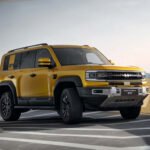The used-car market in Europe is facing a multitude of challenges in 2025, with uncertainties stemming from geopolitical tensions, economic instability, and trade issues. These factors have put pressure on the market, impacting various aspects such as residual values (RVs) and powertrains.
A recent webinar hosted by Autovista Group delved into the current state of the European used-car market and what can be expected by the end of the year. Ana Azofra, Dr. Anne Lange, and Robert Madas, experts from Autovista Group, discussed the influence of economic pressures on the market dynamics and the performance of RVs.
The economic landscape has been tumultuous, with the OECD revising its worldwide GDP growth forecast down to 2.9% for 2025. Inflation rates in the EU have fluctuated, impacting consumer spending power and business investments. The automotive industry is also facing challenges in meeting emissions targets amid evolving regulations and the rapid advancement of electric vehicles (EVs).
Despite these challenges, there have been positive developments in the RVs of three-year-old cars at 60,000km in countries like France, Germany, and Austria, where values have stabilized compared to previous years. However, other countries like Spain and Switzerland have experienced negative corrections due to list price increases.
Looking ahead, a range of RV results are expected across Europe, with some countries forecasted to see significant drops in RVs by the end of 2025. The pressure on powertrains, particularly battery-electric vehicles (BEVs) and full hybrids (HEVs), is also a key concern due to increasing supply and the need to meet CO2 targets.
New brands entering the European market with competitive HEVs are also changing the dynamics of the used-car market. Chinese models, in particular, are offering affordable options that can compete with traditional brands. The performance of these new brands will depend on market strategy and demand for used cars.
Overall, the European used-car market is navigating through a challenging year, with uncertainties and economic pressures shaping the market dynamics and influencing RVs and powertrains. The industry will need to adapt to these changes and innovations to thrive in the evolving landscape. The used-car market is a dynamic and ever-evolving space, with various factors influencing performance. One key aspect that has traditionally been a driver of market performance is a brand’s origin. However, in recent years, this factor has become less significant in determining the success of a used-car brand.
Residual value pressure, shifts in market dynamics, and the momentum of electric vehicles (EVs) have all played a role in reshaping the landscape of the used-car market. As a result, factors such as brand reputation, reliability, and overall value have become more important in driving performance.
Residual value pressure refers to the tendency of certain brands to retain their value better than others. This can be influenced by a variety of factors, including the brand’s reputation for quality, reliability, and customer satisfaction. In the past, a brand’s origin may have played a role in determining its residual value, but in today’s market, other factors carry more weight.
Shifts in market dynamics, such as changing consumer preferences and advancements in technology, have also contributed to the diminishing importance of a brand’s origin. Consumers are now more focused on factors such as fuel efficiency, safety features, and connectivity options when shopping for a used car. As a result, brands that can offer innovative features and a compelling overall package are more likely to succeed, regardless of their origin.
The momentum of EVs is another key factor shaping the used-car market. As electric vehicles become more popular and accessible, traditional combustion engine cars are facing increased competition. Brands that can offer a diverse range of EV options, as well as reliable charging infrastructure and support services, are better positioned to thrive in this new era of automotive technology.
Overall, while a brand’s origin may have been a key driver of used-car market performance in the past, it is no longer the primary factor influencing success. Instead, factors such as residual value pressure, market dynamics, and EV momentum are shaping the future of the used-car market. By focusing on these key areas, brands can position themselves for long-term success and growth in this competitive and rapidly changing industry.







